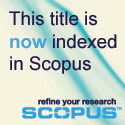JSER Policies
JSER Online
JSER Data
Frequency: quarterly
ISSN: 1409-6099 (Print)
ISSN: 1857-663X (Online)
Authors Info
- Read: 7706
Dragica
MACIC, Snezana NIKOLIC, Daniela ILIC, Tamara TOSIC
OPINIONS
OF HEALTHY ADOLESCENTS CONCERNING
THEIR HANDICAP CLASSMATES
In
this work is presented a part of the research project about the attitudes of
nonchandicapped adolescents toward physical handicapped and chronically ill
persons. The research sample was made of 689 pupils (4th class) from
secondary medical schools and secondary nonmedical schools in
The
results of this work show adolescents inadequate informing for physical
handicape. There are also, a negative direction concerning cognitive components
of the attitude, and mostly positive direction concerning affective component
(except they meet physical handicaped when dominate negative feelings).
Component is reflecting the positiv directions of attitude towards physical
handicapped persons in a short-time relations, and negative direction is case
of intensive and long-time relationships, like tenancy and marriage.
Key words: attitude, physical handicap, adolescent,
connative component, cognitive component and affective component.
Share Us
Journal metrics
-
 SNIP 0.059
SNIP 0.059 -
 IPP 0.07
IPP 0.07 -
 SJR 0.13
SJR 0.13 -
 h5-index 7
h5-index 7 -
 Google-based impact factor: 0.68
Google-based impact factor: 0.68
Related Articles
10 Most Read Articles
- PARENTAL ACCEPTANCE / REJECTION AND EMOTIONAL INTELLIGENCE AMONG ADOLESCENTS WITH AND WITHOUT DELINQUENT BEHAVIOR
- RELATIONSHIP BETWEEN LIFE BUILDING SKILLS AND SOCIAL ADJUSTMENT OF STUDENTS WITH HEARING IMPAIRMENT: IMPLICATIONS FOR COUNSELING
- EXPERIENCES FROM THE EDUCATIONAL SYSTEM – NARRATIVES OF PARENTS WITH CHILDREN WITH DISABILITIES IN CROATIA
- INOVATIONS IN THERAPY OF AUTISM
- AUTISM AND TUBEROUS SCLEROSIS
- THE DURATION AND PHASES OF QUALITATIVE RESEARCH
- REHABILITATION OF PERSONS WITH CEREBRAL PALSY
- DISORDERED ATTENTION AS NEUROPSYCHOLOGICAL COGNITIVE DISFUNCTION
- HYPERACTIVE CHILD`S DISTURBED ATTENTION AS THE MOST COMMON CAUSE FOR LIGHT FORMS OF MENTAL DEFICIENCY
- DIAGNOSTIC AND TREATMENT OPTIONS IN AUTISTIC SPECTRUM DISORDERS – AN OVERVIEW
















